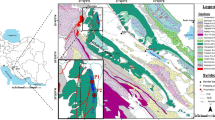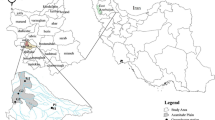Abstract
Karst aquifers are highly heterogeneous, and non-stationary systems in terms of hydrodynamic properties. The investigation of the different transport properties and characteristics of a karst aquifer system (KAS) is of great significance for the management and protection of karst aquifers. To investigate the response of discharge (Q), suspended sediment (SS), and temperature (T) to the precipitation (P), we performed correlation, spectral, and wavelet analyses on the hydrologic time series that included mean daily value from 2009/1/1 to 2015/12/31 from the Nandong underground river system (NURS), a large (> 1600 km2) karst-groundwater basin in southern China. The long memory effects can be determined from the autocorrelation functions of the Q, SS and T implied that the NURS has a significant amount of storage. The sharp and narrow cross-correlation function (CCF) peaks and the cross-wavelet transform (XT) power spectrum of the SS vs. P indicated that the response of the SS to P was shorter than that of the Q and T, and also indicated that the weak memory effect and small inertia of the karst systems with regard to SS. The CCF and XT power spectrum indicated that an increase in Q was the main factor triggering the increase in SS, not precipitation, which is contrary to results determined for other karst springs. Furthermore, the XT and cross-wavelet coherence (TC) of T vs. the air temperature (Ta) was used to demonstrate that Ta is not a direct control on the T in the NURS, which can be misinterpreted when using the traditional correlation and spectral analyses.










Similar content being viewed by others
References
Amraoui F, Razack M, Bouchaou L (2003) Turbidity dynamics in karstic systems. Example of Ribaa and Bittit springs in the Middle Atlas (Morocco). Hydrolog Sci J 48:971–984
Anderson MP (2010) Heat as a ground water tracer. Ground Water 43:951–968
Angelini P (1997) Correlation and spectral analysis of two hydrogeological systems in Central Italy. Hydrolog Sci J 42:425–438
Atkinson T (1977) Diffuse flow and conduit flow in limestone terrain in the Mendip Hills, Somerset (Great Britain). J Hydrol 35:93–110
Aydin H, EkmekÇi M, SOyLU ME (2013) Characterization and conceptualization of a relict karst aquifer (Bilecik, Turkey). Acta Carsologica 42:75-92
Bailly-Comte V, Martin JB, Screaton E (2011) Time variant cross correlation to assess residence time of water and implication for hydraulics of a sink-rise karst system. Water Resour Res 47:143–158
Bonacci O (1993) Karst springs hydrographs as indicators of karst aquifers. Hydrolog Sci J 38:51–62
Bouchaou L, Mangin A, Chauve P (2002) Turbidity mechanism of water from a karstic spring: example of the Ain Asserdoune spring (Beni Mellal Atlas, Morocco). J Hydrol 265:34–42
Charlier J-B, Ladouche B, Maréchal J-C (2015) Identifying the impact of climate and anthropic pressures on karst aquifers using wavelet analysis. J Hydrol 523:610–623
China Geological Survey (2016) Hydrogeological survey report in Nandong Underground River catchment, Mengzi, Yunnan province. Project NO. 12120114062601, Institute of Karst Geology, CAGS, Guilin, China, 280 pp
Delbart C, Valdes D, Barbecot F, Tognelli A, Richon P, Couchoux L (2014) Temporal variability of karst aquifer response time established by the sliding-windows cross-correlation method. J Hydrol 511:580–588
Duffy CJ, Gelhar LW (1986) A frequency domain analysis of groundwater quality fluctuations: interpretation of field data. Water Resour Res 22:1115–1128
Fiorillo F, Doglioni A (2010) The relation between karst spring discharge and rainfall by cross-correlation analysis (Campania, southern Italy). HydJ 18:1881–1895
Ford D, Williams PD (2007) Karst hydrogeology and geomorphology. John Wiley & Sons
Gao M (1995) Time-space variation of water temperature field in the nandong subterranean river system, Yuannan. Carsologica Sinica 14:19–30 ((in Chinese with English abstract))
Hao Y, Zhang J, Wang J, Li R, Hao P, Zhan H (2016) How does the anthropogenic activity affect the spring discharge? J Hydrol 540:1053–1065
Jacob T, Bayer R, Chery J, Jourde H, Le Moigne N, Boy J-P, Hinderer J, Luck B, Brunet P (2008) Absolute gravity monitoring of water storage variation in a karst aquifer on the larzac plateau (Southern France). J Hydrol 359:105–117
Jeannin P-Y, Sauter M (1998) Analysis of karst hydrodynamic behaviour using global approaches: a review. Bull Hydrogéol(Neuchâtel) 16:31–48
Jiang Y, Wu Y, Groves C, Yuan D, Kambesis P (2009a) Natural and anthropogenic factors affecting the groundwater quality in the Nandong karst underground river system in Yunan, China. J Contam Hydrol 109:49–61
Jiang Y, Wu Y, Yuan D (2009b) Human impacts on karst groundwater contamination deduced by coupled nitrogen with strontium isotopes in the Nandong underground river system in Yunan, China. Environ Sci Technol 43:7676–7683
Jiang Z, Lian Y, Qin X (2014) Rocky desertification in Southwest China: Impacts, causes, and restoration. Earth Sci Rev 132:1–12
Kalhor K (2017) Assessment and modeling of groundwater flow and nitrate contamination within coastal karst aquifer of puerto rico. Northeastern University
Kalhor K, Ghasemizadeh R, Rajic L, Alshawabkeh A (2018) Assessment of groundwater quality and remediation in karst aquifers: a review. Groundw Sustain Dev 8:104–121
Kogov J, Petriè M (2003) Tracing tests as a tool for the estimation of possible impacts of human activities on karst waters examples from Slovenia. RMZ-M&G 50:161–164
Labat D, Ababou R, Mangin A (1999) Analyse en ondelettes en hydrologie karstique. 2e partie: analyse en ondelettes croisée pluie-débit. C R Acad Sci 329:881–887
Labat D, Ababou R, Mangin A (2000) Rainfall–runoff relation for karstic springs. Part II: continuous wavelet and discrete orthogonal multiresolution analyses. J Hydrol 238:149–178
Larocque M, Mangin A, Razack M, Banton O (1998) Contribution of correlation and spectral analyses to the regional study of a large karst aquifer (Charente, France). J Hydrol 205:217–231
Li J, Pu J, Zhang T, Xiong X, Wang S, Huo W, Yuan D (2020) Measurable sediment discharge from a karst underground river in southern China: temporal variabilities and controlling factors. Environ Earth Sci 79:1–18
Liu L, Chen X, Xu G, Shu L (2011) Use of hydrologic time-series data for identification of hydrodynamic function and behavior in a karstic water system in China. Hydrogeol J 19:1577–1585
Liu Z (1991) Characterstcs of water temperature in epikarst zone and its comparison with that in lower aeration zone. Carsol Sinica 10:277–282 ((in Chinese with English abstract))
Long AJ (2015) RRAWFLOW: Rainfall-response aquifer and watershed flow model (v1. 15). Geosci Model Dev 8:865–880
Ma ZL (1993) Preliminary study on the geomorphology and its evolution of Nandong underground river basin, Yunnan Province. Carsologica Sinica 12:273–283 ((in Chinese with English abstract))
Mangin A (1984) Pour une meilleure connaissance des systèmes hydrologiques à partir des analyses corrélatoire et spectrale. J Hydrol 67:25–43
Martin JB, Dean RW (1999) Karst modeling-temperature as a natural tracer of short residence times for groundwater in karst aquifers. Karst Model Karst Waters Inst Special Publ 5:236–242
Massei N, Dupont J-P, Mahler B, Laignel B, Fournier M, Valdes D, Ogier S (2006) Investigating transport properties and turbidity dynamics of a karst aquifer using correlation, spectral, and wavelet analyses. J Hydrol 329:244–257
Massei N, Lacroix M, Wang H, Mahler B, Dupont J (2002) Transport of suspended solids from a karstic to an alluvial aquifer: the role of the karst/alluvium interface. J Hydrol 260:88–101
Massei N, Wang H, Dupont J, Rodet J, Laignel B (2003) Assessment of direct transfer and resuspension of particles during turbid floods at a karstic spring. J Hydrol 275:109–121
Mayaud C, Wagner T, Benischke R, Birk S (2014) Single event time series analysis in a binary karst catchment evaluated using a groundwater model (Lurbach system, Austria). J Hydrol 511:628–639
Mcconnell CL (1993) Double porosity well testing in the fractured carbonate rocks of the Ozarks. Groundwater 31:75–83
Morlet J, Arens G, Fourgeau E, Glard D (1982) Wave propagation and sampling theory—part I: complex signal and scattering in multilayered media. Geophysics 47:203–221
Mo M (2017) Study on the boundary and structural characteristics of NanDong underground river system in yunnan. Kunming University of Science and Technology (in Chinese with English abstract)
Padilla A, Pulido-Bosch A (1995) Study of hydrographs of karstic aquifers by means of correlation and cross-spectral analysis. J Hydrol 168:73–89
R Core Team (2019) R: A language and environment for statistical computing. R Foundation for Statistical Computing. R Version 3.4.3, Vienna, Austria. https://www.R-project.org.Accessed 15 Mar 2019
Roesch A, Schmidbauer H (2018a) WaveletComp 1.1: A guided tour through the R package. URL: http://www.hsstat.com/projects/WaveletComp/WaveletComp_guided_tour.pdf
Roesch A, Schmidbauer H (2018) WaveletComp: Computational Wavelet Analysis. R package version 1:1
RStudio Team (2019) RStudio: Integrated Development for R. R Studio Inc, Boston, Massachusetts
Salerno F, Tartari G (2009) A coupled approach of surface hydrological modelling and Wavelet Analysis for understanding the baseflow components of river discharge in karst environments. J Hydrol 376:295–306
Shuster ET, White WB (1971) Seasonal fluctuations in the chemistry of lime-stone springs: A possible means for characterizing carbonate aquifers. J Hydrol 14:0–128
Thraikill J (1988) Drawdown interval analysis: a method of determining the parameters of shallow conduit-flow carbonate aquifers from pumping tests. Water Resour Res 24:1423–1428
Torrence C, Compo GP (1998) A practical guide to wavelet analysis. Bull Amer Meteorol Soc 79:61–78
Valdes D, Dupont J-P, Massei N, Laignel B, Rodet J (2005) Analysis of karst hydrodynamics through comparison of dissolved and suspended solids’ transport. C R Geosci 337:1365–1374
Yuan D, Zhang C (2008) Karst dynamics theory in China and its practice. Acta Geoscientica sinica 29:355–365 ((in Chinese with English abstract))
Zhao Y, Li Y, Tan X, Hong T, Cheng D, Lan F (2017) Tracer tests on distribution and structural characteristics of karst channels in Nandong underground river drainage. Carsologica Sinica 36:226–233 ((in Chinese with English abstract))
Zhang R (1992) Speleology research on Nandong subterranean river basin KaiYuan. YuanNan Carsologica Sinica 11:366–382 ((in Chinese with English abstract))
Acknowledgements
Financial support for this research was provided by the Key Research & Development Fund of Ministry of Science and Technology of China (NO.2016YFC0502501), and the Guangxi Natural Science Foundation (2017GXNSFFA198006, 2018GXNSFBA138031). We also sincerely thank two anonymous reviewers and editors for their thoughtful comments and suggestions, which greatly improved the original draft.
Author information
Authors and Affiliations
Corresponding author
Ethics declarations
Conflict of interest
The authors declare that they have no conflict of interest.
Additional information
Publisher's Note
Springer Nature remains neutral with regard to jurisdictional claims in published maps and institutional affiliations.
Supplementary Information
Below is the link to the electronic supplementary material.
Rights and permissions
About this article
Cite this article
Li, J., Pu, J., Zhang, T. et al. Investigation of transport properties and characteristics of a large karst aquifer system in southern China using correlation, spectral, and wavelet analyses. Environ Earth Sci 80, 84 (2021). https://doi.org/10.1007/s12665-020-09366-9
Received:
Accepted:
Published:
DOI: https://doi.org/10.1007/s12665-020-09366-9




